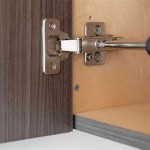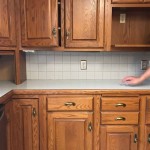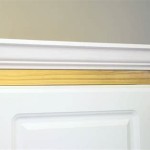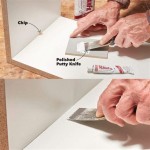How to Keep White Kitchen Cabinets Clean
White kitchen cabinets offer a bright, clean, and timeless aesthetic that appeals to many homeowners. Their neutral color reflects light, making the kitchen feel more spacious and airy. However, this pristine appearance comes with a significant challenge: maintaining cleanliness. White surfaces readily show dirt, grease, spills, and fingerprints, requiring diligent and consistent cleaning efforts to prevent discoloration and damage.
The key to successfully keeping white kitchen cabinets clean lies in a combination of preventative measures, regular cleaning routines, and appropriate cleaning products and techniques. This article will delve into effective strategies for preserving the beauty and longevity of white kitchen cabinets by addressing common staining culprits and detailing practical cleaning methods.
Preventative Measures: The First Line of Defense
Prevention is significantly more effective and less time-consuming than trying to remedy heavy staining. Implementing preventative measures can dramatically reduce the frequency and intensity of cleaning required to maintain white kitchen cabinets. These measures focus on containing messes and minimizing exposure to common kitchen contaminants.
One crucial preventative measure is immediate spill cleanup. Any spills, whether it's coffee, tomato sauce, oil, or juice, should be wiped up immediately with a clean, damp cloth. Allowing spills to sit on the surface will increase the likelihood of staining, making them far more difficult to remove later. Keeping a stack of microfiber cloths readily available near the sink is a practical way to ensure quick action.
Another important strategy is to utilize a range hood while cooking. The range hood effectively vents steam, grease, and other airborne particles that can settle on cabinet surfaces, leading to a sticky buildup over time. Regularly cleaning the range hood filter will also contribute to preventing grease from accumulating on the cabinets. Clean the filter at least once a month, or more frequently if the cooking generates a lot of grease.
Strategic placement of items within the cabinets can also minimize the risk of spills and leaks. Storing oils, sauces, and other potentially staining liquids in sealed containers is advisable. Lining cabinet shelves with shelf liners, such as non-adhesive ribbed liners, adds a protective barrier against potential leaks and spills. These liners are easily removable and can be cleaned or replaced as needed.
Furthermore, consider using a kitchen backsplash. Backsplashes protect the wall area behind the stove and sink from splatters and spills. While they don't directly protect the cabinets, they reduce the overall amount of airborne grease and moisture in the kitchen, indirectly contributing to cleaner cabinets.
Establishing a Regular Cleaning Routine
While preventative measures minimize the accumulation of dirt and grime, a regular cleaning routine is essential for maintaining the pristine appearance of white kitchen cabinets. The frequency of cleaning will depend on cooking habits and the level of activity in the kitchen, but a general guideline is to clean cabinets weekly or bi-weekly.
The weekly cleaning routine should involve wiping down the cabinet surfaces with a mild cleaning solution. A simple solution of warm water and dish soap is often sufficient for removing light dirt and fingerprints. Use a soft, non-abrasive cloth or sponge to avoid scratching the cabinet finish. Always wipe in the direction of the wood grain, if applicable.
For areas that are prone to grease buildup, such as around the stove and handles, a slightly stronger cleaning solution may be needed. A mixture of warm water and baking soda can be effective for cutting through grease. Apply the paste to the greasy areas, let it sit for a few minutes, and then gently scrub with a soft cloth. Rinse thoroughly with clean water and dry with a clean cloth.
Pay particular attention to the areas around the handles and knobs. These areas are frequently touched and can accumulate dirt and grime quickly. Regularly cleaning these areas will prevent the dirt from becoming embedded in the finish.
In addition to the weekly cleaning, it is beneficial to perform a more thorough cleaning monthly. This involves cleaning the inside of the cabinets as well. Remove all items from the cabinets and wipe down the shelves and walls with a damp cloth. This is also a good opportunity to check for any spills or leaks that may have occurred and clean them up promptly.
Choosing Appropriate Cleaning Products and Techniques
Selecting the right cleaning products and techniques is crucial for effectively cleaning white kitchen cabinets without damaging the finish. The type of finish on the cabinets (e.g., painted, laminated, thermofoil) will influence the appropriate cleaning method.
For painted cabinets, avoid using harsh chemicals, abrasive cleaners, or scouring pads, as these can scratch or damage the paint. A mild dish soap solution is generally safe and effective. For more stubborn stains, consider using a dedicated cabinet cleaner specifically formulated for painted surfaces. Always test the cleaner in an inconspicuous area first to ensure it does not discolor or damage the finish.
Laminated cabinets are generally more durable and resistant to staining than painted cabinets. However, it is still important to avoid using abrasive cleaners, as these can scratch the surface. A mild dish soap solution or a dedicated laminate cleaner can be used. Ensure the surface is thoroughly dried after cleaning to prevent water spots.
Thermofoil cabinets are susceptible to heat damage, so it is important to avoid using excessive heat when cleaning them. Avoid using steam cleaners or placing hot pots and pans directly on the surface. A mild dish soap solution is generally safe and effective for cleaning thermofoil cabinets. Avoid using harsh chemicals or abrasive cleaners, as these can damage the finish.
Regardless of the cabinet finish, always use soft, non-abrasive cloths or sponges for cleaning. Microfiber cloths are excellent for cleaning cabinets as they are gentle and effective at removing dirt and grime. Avoid using paper towels, as they can leave behind lint.
When dealing with stubborn stains, such as grease or ink, several alternative cleaning methods can be employed. A paste of baking soda and water can be effective for removing grease stains. Apply the paste to the stain, let it sit for a few minutes, and then gently scrub with a soft cloth. Rinse thoroughly with clean water and dry with a clean cloth.
For ink stains, try using a small amount of rubbing alcohol on a cotton ball. Gently dab the stain with the alcohol, being careful not to spread it. Rinse thoroughly with clean water and dry with a clean cloth. Always test the alcohol in an inconspicuous area first to ensure it does not discolor or damage the finish.
Oil soaps and polishes can be used to add a protective layer to the cabinets and make them easier to clean in the future. However, use these products sparingly, as excessive use can lead to a buildup of residue. Follow the manufacturer's instructions carefully when using these products.
Pay special attention to cleaning cabinet hardware, such as handles and knobs. These areas can accumulate dirt and grime quickly. Use a mild dish soap solution and a soft cloth to clean the hardware. For stubborn dirt, try using a toothbrush to scrub the crevices.
Always rinse the cabinets thoroughly with clean water after cleaning to remove any soap residue. Soap residue can attract dirt and grime, making the cabinets appear dirty more quickly. Dry the cabinets with a clean cloth to prevent water spots.
Finally, it is important to regularly inspect the cabinets for any signs of damage, such as scratches, chips, or water damage. Addressing these issues promptly will prevent them from worsening and extend the lifespan of the cabinets.

How To Clean White Kitchen Cabinets 3 Best Ways Avoid Abbotts At Home

3 Super Easy Ways To Clean White Kitchen Cabinets And Avoid

How To Clean White Kitchen Cabinets 3 Best Ways Avoid Abbotts At Home

The Complete Guide To Keeping White Cabinets Clean Cabinet Now

Are White Cabinets Hard To Keep Clean Southington Painting

How To Keep Your White Kitchen

What S The Best Way To Clean Your White Kitchen Cabinets Ag Williams

How To Keep White Cabinets Clean While Having Children

The Complete Guide To Keeping White Cabinets Clean Cabinet Now

5 Simple Tips To Keep A White Kitchen Clean Domestically Blissful
Related Posts








